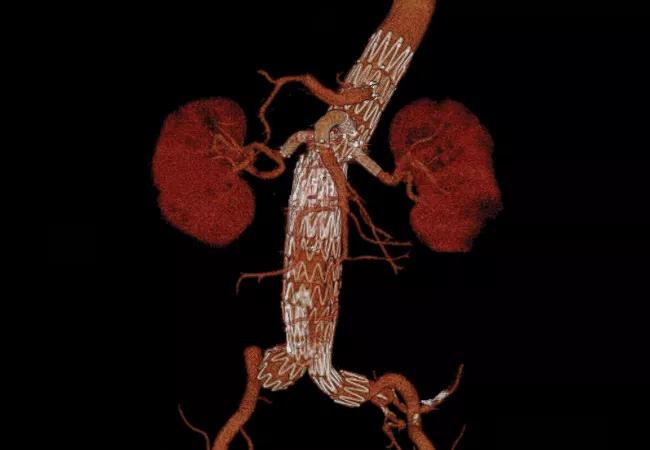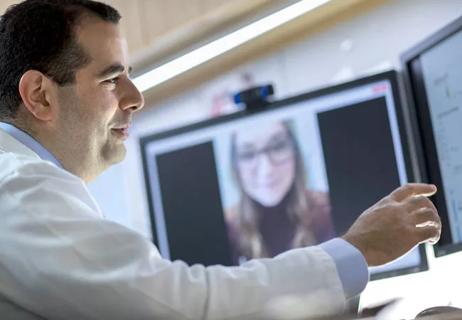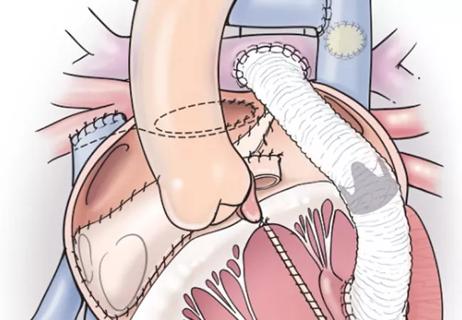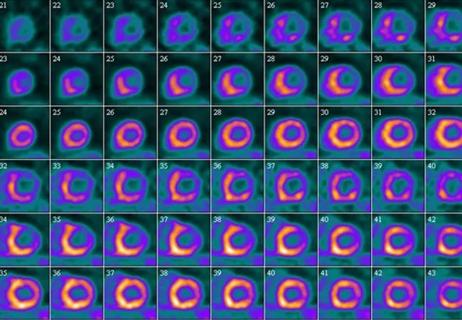EVAR pioneer Dr. Juan Parodi surveys the past and future of a revolutionary procedure

Thirty years ago, vascular surgeon Juan Parodi, MD, set in motion what has since been recognized as an endovascular revolution in the treatment of abdominal aortic aneurysms.
Advertisement
Cleveland Clinic is a non-profit academic medical center. Advertising on our site helps support our mission. We do not endorse non-Cleveland Clinic products or services. Policy
On September 7, 1990, Dr. Parodi teamed with vascular radiologist Julio Palmaz, MD, to perform the world’s first successful endovascular aneurysm repair (EVAR). The minimally invasive procedure was done under local anesthesia in a 70-year-old man with severe back pain associated with a 6-cm abdominal aortic aneurysm. It involved placement of a graft designed by Dr. Parodi that consisted of expandable ends, an extra-large Palmaz stent, a Teflon sheath with valve, a wire, and a valvuloplasty balloon. The patient fared well, surviving for nine years after the procedure before dying from cancer.
While this historic first EVAR took place in Dr. Parodi’s native Argentina, the procedure’s roots can be traced back to Cleveland Clinic, where Dr. Parodi first conceived of the technique during his vascular surgery training at the institution in the mid-1970s.
Following poor outcomes from two abdominal aortic aneurysm open repairs on a single day, the young Dr. Parodi floated an alternate approach with his Cleveland Clinic vascular surgeon mentors, Alfred Humphries, MD, and Edwin Beven, MD. He suggested that it might make sense to try performing the Seldinger technique with a larger catheter and introduce a compressed graft and metal component in lieu of the suture, thereby accomplishing the repair transfemorally.
“My idea was to exclude the aneurysm from the circulation and prevent rupture,” Dr. Parodi explains. “I thought we could use a fabric graft and metal components to affix and seal the elements in place using an endovascular retrograde access. The goal was an endoluminal technique for a less invasive and morbid procedure that was equally effective as open aneurysm repair.”
Advertisement
He began his early experimental work, including engineering the first prototypes with elastic stainless steel wires, at Cleveland Clinic in 1976, and then continued developing the concept back home in Argentina. He met his collaborator Dr. Palmaz, a fellow Argentinian, in the 1980s and began using a redesigned version of his Palmaz stent in animals, eventually leading to the first human case in September 1990. All his work up to that point was done without external funding support.
Dr. Parodi notes that on the same day as the first EVAR case, his team performed an open aneurysm repair in another patient. When the team checked on the two patients after dinner, the EVAR patient was having dinner while the other patient was still intubated. “That was a strong signal that we were likely on the right track,” Dr. Parodi says.
As Dr. Parodi performed additional EVAR cases in the following months, he began to observe leaks in the distal part of the grafts in patients if the distal aortic neck was too short. His team experimented with graft redesigns and eventually proceeded with an aorto-uni-iliac graft in 1991 that initially occluded the contralateral limb with a detachable balloon and later with a covered stent.
Further refinements followed in response to various challenges that arose, such as creation of a temporary Dacron graft conduit in cases with a narrow external iliac artery or performance of anastomosis between the external iliac artery and the hypogastric artery in the setting of an iliac aneurysm with an endangered internal iliac artery.
Advertisement
Soon Dr. Parodi began sharing his EVAR technique with colleagues around the world, starting with the landmark publication of his team’s first five cases in Annals of Vascular Surgery (1991;5:491-499). Notably, the fourth of these initial five cases involved successful treatment of an infrarenal aortic dissection, representing the first of countless aortic dissections subsequently treated with endografts.
In 1992, Dr. Parodi introduced the EVAR technique to vascular surgeons in Europe and the United States. Subsequent uptake of the procedure was swift, with technological advancements in devices for endovascular repair following in short order. As a result, approximately 80% of abdominal aortic aneurysms today are treated with an endovascular approach, and the cumulative worldwide total of EVAR cases surpassed 1 million in 2019.
The evolution of EVAR in the early 2000s was driven at Cleveland Clinic by the late Roy Greenberg, MD, a vascular surgeon who helped develop thoracic, thoracoabdominal and arch branched and fenestrated grafts. Today’s stent grafts — fabric tubes supported by a wire scaffold — are guided to the aneurysm site and deployed to seal off the aneurysmal aorta segment, with the graft relining the aorta like an inner tube.
In tandem with this expansion and refinement of EVAR, the annual number of deaths from intact and ruptured aneurysms has steadily decreased in the developed world. Likewise, EVAR helped accelerate the adoption of endovascular strategies by vascular surgeons. This led to the use of endovascular strategies for every area of vascular disease, from the carotid arteries in the neck to the renal and mesenteric arteries in the abdomen and the arteries of the entire lower extremity.
Advertisement
“We are excited to continue the legacy of innovation that Dr. Parodi started and our own Dr. Greenberg built upon together with our outstanding aorta team of innovators,” says Lars Svensson, MD, PhD, Chair of Cleveland Clinic’s Miller Family Heart, Vascular & Thoracic Institute.
“Our cardiothoracic and vascular teams continue to lead in endovascular trials evaluating new devices for the entire aorta, from the ascending, to the aortic arch, to the thoracoabdominal segment,” adds Sean Lyden, MD, Chair of Vascular Surgery at Cleveland Clinic.
At the same time, he and his colleagues have also seen how the inappropriate use of these novel devices and techniques can sometimes lead to repair failure. In those cases, cardiac and vascular surgeons work collaboratively across the Heart, Vascular & Thoracic Institute to treat complex failures, often using combined open and endovascular approaches. “Endovascular device failure, whether in the thoracic or the abdominal aorta, often results in a condition requiring advanced endovascular techniques or open aortic replacement,” says Cleveland Clinic vascular surgeon Francis Caputo, MD. “This is best handled by a multidisciplinary team of aortic experts working to achieve the best outcomes for patients tailored to their specific condition.”
Meanwhile, surgical teams continue to innovate hybrid approaches to achieve durable results. An example pioneered at Cleveland Clinic is the frozen elephant trunk procedure for high-risk patients with extensive aortic disease. “We embraced endovascular technology early in its development with the perspective that it complements what we do with conventional surgical techniques instead of seeing it as competitive,” says Eric Roselli, MD, Chief of Adult Cardiac Surgery at Cleveland Clinic. “Consistent with our patients-first, collaborative approach to care, we have learned how to tailor the various open and endovascular strategies to each patient with a cardio-aortic condition in a hybrid way to provide the best treatment option.”
Advertisement
Advertisement

General principles for use of the long-awaited new therapy approach

Latest systems combine continuous glucose monitoring with automatic basal insulin delivery

Common congenital lesion is not always benign

New study yields pre-pandemic insights for the post-pandemic landscape

Series of five patients successfully treated with ‘ventricular switch’

Results also show eagerness to learn more

Cleveland Clinic-developed tool guides referrals and predicts mortality

Why and how we encourage phase-of-care mortality analysis among our affiliated programs